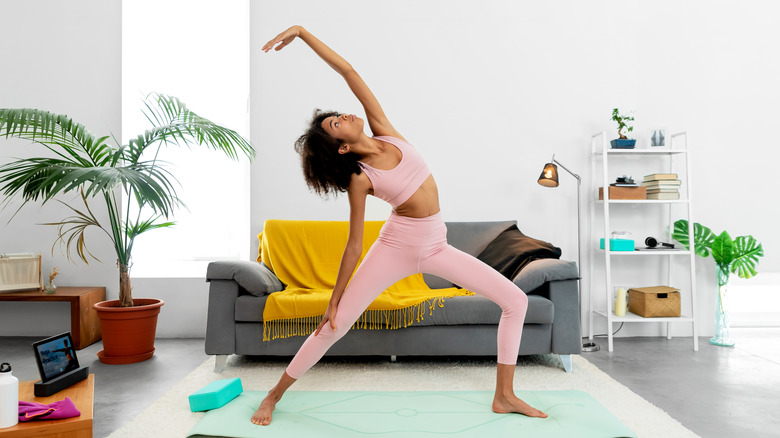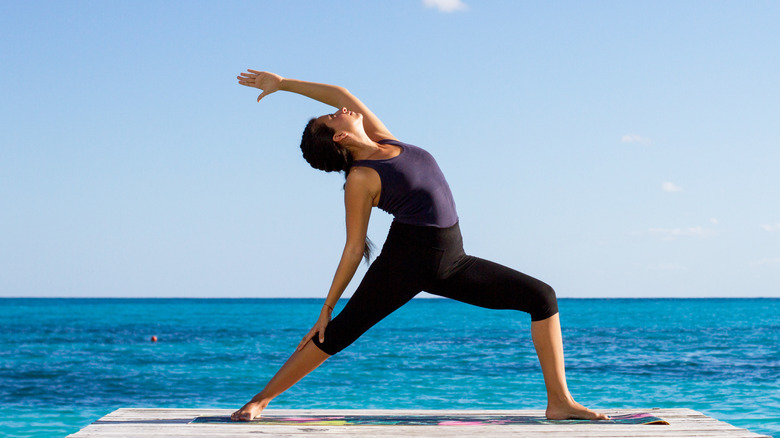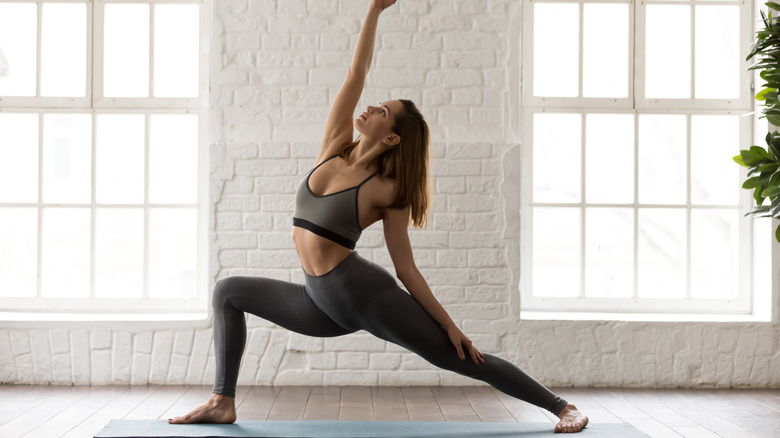The Benefits Of Doing Reverse Warrior Pose In Yoga
Warrior poses are strong standing poses that you'll find at all levels of any yoga class. You're probably familiar with warrior 1, which often comes after a downward dog. An instructor might call you to open up into warrior 2 following a lunge. And a reverse warrior might follow after warrior 2 or triangle pose. It's a chance for you to change things up from many of the forward bends so you can open up other parts of the body.
The main benefit of reverse warrior pose is to open up the side body. The intercostal muscles between your ribs can easily get compressed, which can limit your ability to take a deep, full breath. Reverse warrior is still a standing pose, which means that you're building strong, stable legs in this posture. You'll also find that reverse warrior can improve the mobility in your hips because you're getting a good stretch (via Ekhart Yoga). Reverse warrior can also improve overall circulation, which might help shuttle away some of the tension stored in your body. This side-body stretch might also ease any pain in your lower back (via Modern Yoga).
How to do reverse warrior pose
Start in mountain pose, which is standing tall with your feet planted at the back of your mat. Step your right foot forward like you're doing a lunge, bending deep into the front knee. Your feet can be slightly wider than hip width for stability. While opening your left hip toward the back of the mat, spin your left foot 90 degrees so your toes point toward the left edge of your mat. Your left heel should anchor down into the mat. Adjust your stance so that your feet aren't too far apart, but keep bending through the right knee. Your torso should be facing the left.
Extend your arms out to your sides for a brief moment and feel warrior 2. For reverse warrior, drop your left hand to your left thigh. Flip your right palm, open your right shoulder, and reach up with your right arm. Using your core muscles for stability, reach your torso toward the back of the mat, trying to keep your arms, torso, and legs on the same plane. You can gaze up at your right hand, but remember to keep a bend in your right knee. Take a few breaths, feeling the right side of your torso getting a deep stretch, then bring your arms and torso back into warrior 2 (via Everyday Yoga).
When to skip or modify reverse warrior pose
According to Tummee, reverse warrior can be tough if you're recovering from any injury to your neck, shoulders, knees, or hips. You'll need to modify the pose by sitting on a chair to avoid putting too much pressure on your lower body. You'll open the front leg off the side of the chair while anchoring the back leg off the opposite side of the chair.
If your injury is in the upper body, you might want to skip arching the arm and torso away from your front leg. People with high or low blood pressure, dizziness, or headaches might also want to avoid the side-bending posture of reverse warrior. Anyone recovering from surgery around their torso should skip reverse warrior pose altogether.
If your legs are feeling weak, you can try reverse warrior pose by placing the back knee on the floor. You can start in the lunge position, but place the back knee down. As you open your torso to the side, the shin of your back leg will move so it's perpendicular to the back edge of the mat. This will give you added stability as you arch your torso toward the back of your mat.



